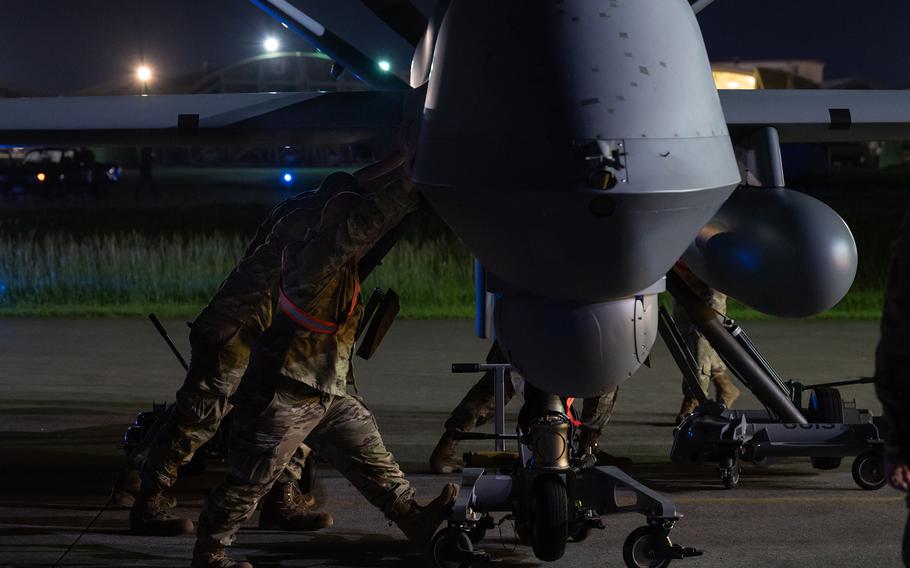
Maintenance personnel push an MQ-9 Reaper into an aircraft shelter at Kadena Air Base, Okinawa, Oct. 13, 2023. (Tylir Meyer/U.S. Air Force)
CAMP FOSTER, Okinawa — The U.S. Air Force has completed a transfer of MQ-9 Reaper drones to Okinawa from a Japanese air force base farther north, a Japanese defense official said this week.
Six Reapers from the 319th Expeditionary Reconnaissance Squadron arrived at Kadena Air Base between Oct. 13 and Oct. 22, according to the Kyushu Defense Bureau’s website. The drones came from Kanoya Air Base, a Japan Maritime Self-Defense Force installation on Kyushu, the southernmost of Japan’s four main islands.
The Reapers are already flying intelligence, surveillance and reconnaissance missions over Japan’s southern island chain in close coordination with Japan’s Ministry of Defense, 1st Lt. Robert Dabbs, a spokesman from Kadena’s 18th Wing, said by email Thursday.
“The MQ-9s at Kadena are conducting … missions to enhance our senior leaders’ ability to make informed decisions that help maintain a free and open Indo-Pacific,” he said. “All operations will occur in accordance with our agreements with Japan and international law.”
Two Reapers will remain at Kanoya until Tuesday, when they will be withdrawn, an Okinawa Defense Bureau spokesman said by phone Thursday. He would not comment on where the drones are headed next.
The bureaus represent Japan’s Defense Ministry on their respective islands. Some government officials in Japan may speak to the media only on condition of anonymity.
The Reaper, made by General Atomics of San Diego, is a medium-altitude, long-endurance, remotely operated aircraft used primarily for surveillance, according to the Air Force. They are capable of carrying a combination of Hellfire missiles and Paveway laser-guided bombs.
Their mission in southern Japan consists primarily of monitoring potential flashpoints across the Indo-Pacific and providing time-sensitive intelligence to U.S. commanders, allies and partners, including an intelligence analysis cell made up of U.S. and Japanese military officials, 18th Wing spokesman Lt. Col. Raymond Geoffroy said last month.
The plan to move the Reapers to Kadena was announced Oct. 6. About 150 airmen from the reconnaissance squadron and eight Reapers had been based at Kanoya for about a year. The unmanned aircraft are originally from Creech Air Force Base, Nev.
The Reapers will be operating out of the southern air hub for the foreseeable future, Geoffroy said.
From Kadena, the Reapers can reach the disputed Senkaku Island chain in half the time the trip took from Kanoya, the bureau website said. The Senkakus, a string of five uninhabited islands and three rocks 105 miles east of Taiwan, are administered by Japan but claimed by both Taiwan and China.
Japan wanted the drones based in the southern isles because of a heightened need for information gathering due to the increased activities of potential adversaries, Japanese Defense Minister Seiji Kihara said Oct. 10.
China in recent years has stepped up challenges to its neighbors’ maritime claims in the East and South China Seas. Its coast guard frequently enters seas claimed by Japan around the Senkakus.
After learning about the deployment last month, Okinawa Gov. Denny Tamaki called the plan unacceptable and asked the Okinawa Defense Bureau to reconsider, he wrote in a letter published to a prefectural X account, formerly known as Twitter.
He acknowledged an increasingly severe security environment but called the drones burdensome on Okinawa.